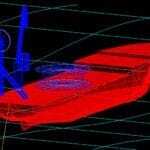Published by Stewart Technologies on April 20, 2016

There are hundreds of software solutions for the oil and gas industry that can make the job of finding, drilling for, and producing oil and gas much easier, safer, and cost-effective. The software solutions range from programs that automate control systems or provide safety solutions, such as man overboard warnings, to software that is designed to map out and determine the viability of a formation, or to analyze the structure of marine systems and the effect of hydrodynamic forces on them.
Oil and gas software such as Orcaflex, Orcina, Saic, or Atkins can be used to design and analyze marine systems such as oil rigs, liftboats, jack-ups, anchors, pipelines, single-point moorings and other marine systems, making sure that they will operate safely in the chosen environment and have decent lifespans. GIS, or geological information systems software, can help to collate available geological data, such as maps, well logs, mud logs, and other data, and use it to determine the overall make-up and viability of a formation, including cross-section generation and analysis. Other types of software can manage production, logistics supplies, or specific hardware systems.
Here are just a few of the ways that oil and gas software can help to improve your company’s operations:
#1 Design Analysis
Whether you are designing a semi-submersible rig, a jack-up or floating platform, the right oil and gas software can help you to perfect the design long before it goes into production, and put it through its paces virtually, with thorough software-based testing and analysis.
This allows you to make sure that your design will work as expected in the worst conditions, such as when the wind is blowing in hurricane-force gusts, or the waves are hitting the rig with incredible force. Using the information from the virtual testing and analysis, you can improve the design of the right to withstand wave action, sub-sea pressures, tidal forces, and the worst weather conditions to be expected at the site.
Once you are sure that your design meets all of your needs and specifications, you can then put it into production. By analyzing the design with oil and gas software such as OrcaFlex first, you can avoid costly production mistake that costs thousands or more to fix, as well as tedious maintenance issues further down the line.
#2 Hydrodynamic Analysis
From the largest oil rigs to the smallest mooring points and clamps, every marine system is prone to structural damage through the forces of wave action, tidal forces, inclement weather, large sub-sea pressures, corrosion and other issues unique to marine environments. In order to be cost-effective, any system used in a marine environment must strike a balance between longevity and total cost of ownership. Structures built to handle the worst forces in a marine environment may be too expensive to be cost-effective, while less expensive structures may cost your more over their lifetimes due to increased maintenance costs.
Oil and gas software such as OrcaFlex can help you perform an accurate hydrodynamic analysis on just about any type of marine system, allowing you to study how the forces of the marine environment will affect the system. By doing a thorough analysis, you can improve the design of your mooring system, pipeline, riser system or other marine equipment. This will help you to design components that stand up to the unique stresses of the marine environment better, reducing maintenance costs, extending the lifespan of the equipment, and keeping your total cost of ownership reasonable.
#3 Financial Assessments
Oil and gas software can help your company plan your oil and gas exploration and production operations from start to finish. This includes estimating the required investment in equipment, such as oil rigs, drilling risers, pipelines, mooring systems, to analyzing geological data and estimating well viability and output. It can help you to determine the total costs associated with the operation and the potential profits.
It can also help you to determine possible risks, such as oil spills, environmental damage, injuries and accidents, and help you to determine the best courses of action in each situation and possible costs associated with them. With oil and gas software, you can have complete control over every aspect of your burliness, with instantaneous access to detailed information, analysis and reports that are critical to your operations.
#4 Marine Simulations
Oil and gas software can also help during training and certification of employees and other staff. Software simulators, such as jack-up or ballast control simulators can help new operator become familiar with the control systems in such equipment without risk to the physical equipment or crew. This reduce liability and overall training costs, and allows you to safely train your crew with fewer risks.
Jack-up simulators can mimic nearly any step in the operation of a jack-up rig, including how the system responds to problems such as a broken leg, a punch through, or poor contact with the sea floor. Ballast simulators allow the operator to empty or fill the ballasts of a ship or rig in accordance to weather conditions, preventing the system from sinking or tipping over in rough seas.
#5 Forensic Analysis
If there is an accident or oil spill at one of your sites, oil and gas software can help you to determine the cause of the accident, who is responsible and how to prevent such problems in the future. Software tools such as hydrodynamic analysis can be critical in the analysis of the problem and in finding a solution, and software like OrcaFlex can make the process much easier.
By making your equipment safer through hydrodynamic analysis and by preventing accidents in the future, you can reduce your company’s liabilities and increase long-term profits.
Oil and gas software, such as OrcaFlex, GIS software and training simulators, can help your business run more efficiently, safely and smoothly. It can help you to design better structures that can easily withstand the unique forces in a marine environment, it can help you to improve your training processes, it can prevent accidents and it can analyze financial risks to your company and help reduce operational costs.
Sources:
http://www.rigzone.com/training/insight.asp?insight_id=339&c_id=24


